GLIS - (GL)obal optimization by (I)nverse distance weighting and (S)urrogate radial basis functions
Project description
GLIS / GLISp / C-GLISp

Contents
Package description
GLIS is a package for finding the global (GL) minimum of a function that is expensive to evaluate, possibly under constraints, using inverse (I) distance weighting and surrogate (S) radial basis functions. Compared to Bayesian optimization, GLIS is very competitive and often computationally lighter.
The package implements two main algorithms, described here below.
GLIS
The GLIS algorithm solves the following constrained derivative-free global optimization problem
$$\min_x f(x)$$
$$l \leq x\leq u$$
$$Ax \leq b,\ g(x)\leq 0$$
The approach is particularly useful when $f(x)$ is time-consuming to evaluate, as it attempts at minimizing the number of function evaluations by actively learning a surrogate of $f$.
Finite bounds $l \leq x\leq u$ are required to limit the search within a bounded set, the remaining constraints are optional.
The algorithm is based on the following paper:
[1] A. Bemporad, "Global optimization via inverse weighting and radial basis functions," Computational Optimization and Applications, vol. 77, pp. 571–595, 2020. [bib entry]
GLISp
GLISp solves global optimization problems in which the function $f$ cannot be evaluated but, given two samples $x$, $y$, it is possible to query whether $f(x)$ is better or worse than $f(y)$. More generally, one can only evaluate a preference function $\pi(x,y)$
$\pi(x,y) = -1$ if $x$ is better than $y$
$\pi(x,y) = 1$ if $x$ is worse than $y$
$\pi(x,y) = 0$ if $x$ is as good as $y$,
and want to solve the following preference-based optimization problem:
find $x^*$ such that $\pi(x^*,x)\leq 0$ $\ \forall x$
with $x^*,x$ satisfying the constraints $l \leq x\leq u$, and, if present, $Ax \leq b$, $g(x)\leq 0$.
GLISp is particularly useful to solve optimization problems that involve human assessments. In fact, there is no need to explicitly quantify an objective function $f$, which instead remains unexpressed in the head of the decision-maker determining the preferences. A typical example is solving a multi-objective optimization problem where the exact priority of each objective is not clear.
The algorithm is based on the following paper:
[2] A. Bemporad, D. Piga, "Active preference learning based on radial basis functions," Machine Learning, vol. 110, no. 2, pp. 417-448, 2021. [bib entry]
C-GLISp
C-GLISp is an extension of GLIS and GLISp to handle unknown constraints on $x$, $x\in X_u$, where the shape of the set $X_u$ is completely unknown and one can only query whether a certain $x\in X_u$ or $x\not\in X_u$. A typical case is when $f(x)$ is the result of an experiment or simulation, parameterized by $x$, and one labels $x\not\in X_u$ if the experiment could not be executed. The algorithm also supports labeling samples $x$ as satisfactory or not, for example an experiment could be carried out but the outcome was not considered satisfactory. Both additional information (feasibility with respect to unknown constraints and satisfaction) are used by GLIS or GLISp to drive the search of the optimal solution.
The algorithm is based on the following paper:
[3] M. Zhu, D. Piga, A. Bemporad, "C-GLISp: Preference-based global optimization under unknown constraints with applications to controller calibration,” IEEE Trans. Contr. Systems Technology, vol. 30, no. 3, pp. 2176–2187, Sept. 2022. [bib entry]
Installation
pip install glis
A MATLAB version of GLIS/GLISp is also available for download here.
Basic usage
Global optimization (GLIS)
Minimize a function $f$ of a vector $x\in\mathbb{R}^n$ within the finite bounds lb $\leq x\leq$ ub:
from glis.solvers import GLIS
prob = GLIS(bounds=(lb, ub), n_initial_random=10) # initialize GLIS object
xopt, fopt = prob.solve(fun, max_evals) # solve optimization problem
where fun is a Python function that, given a sample to query, returns $f(x)$. For example, fun can be a function invoking a simulator and returning the key performance index to minimize. The parameter n_initial_random is the number of random samples taken at initialization by Latin Hypercube Sampling (LHS), and max_evals is the total allowed budget of function evaluations. The code returns the optimizer xopt and the corresponding minimum value fopt=fun(xopt) found.
If it becomes possible to obtain additional samples after running the optimization, the latter can be continued as follows:
x = prob.xnext # next sample to query
f = fun(x) # function evaluation
x = prob.update(f) # update GLIS object
xopt = prob.xbest # updated optimizer
fopt = prob.fbest # updated optimum
Alternatively, for a full step-by-step optimization without explicitly passing the function handle fun to GLIS, use the following code structure to solve the problem step by step:
from glis.solvers import GLIS
prob = GLIS(bounds=(lb, ub), n_initial_random=10) # initialize GLIS object
x = prob.initialize() # get first sample to query
for k in range(max_evals):
f = fun(x)
x = prob.update(f)
xopt = prob.xopt # final optimizer
fopt = prob.fopt # final optimum
Example
Minimize the camel-six-humps function
$$f(x_1,x_2) = \left(4 - 2.1x_1^2 + \frac{x_1^4}{3}\right) x_1^2+x_1x_2+4(x_2^2-1)x_2^2$$
for $-2\leq x_1\leq 2$, $-1\leq x_2\leq 1$. The function has the global minimum $f(x^) = -1.0316$ attained at $x^ = (0.0898, -0.7126)$ and $x^*= (-0.0898, 0.7126)$. GLIS minimizes $f(x)$ as follows:
lb = np.array([-2.0, -1.0])
ub = np.array([2.0, 1.0])
fun = lambda x: ((4.0 - 2.1 * x[0] ** 2 + x[0] ** 4 / 3.0) *
x[0] ** 2 + x[0] * x[1] + (4.0 * x[1] ** 2 - 4.0) * x[1] ** 2)
prob = GLIS(bounds=(lb, ub), n_initial_random=10)
xopt, fopt = prob.solve(fun, max_evals=60)
In this case we obtain xopt = [0.09244155, -0.7108227], fopt =-1.0316. Note that the final result depends on the outcome of the initial random sampling phase, so final values found by GLIS may differ from one run to another.
The sequence xseq of samples acquired, the corresponding
function values fseq, and the sequence fbest_seq of
best values found during the iterations can be retrieved as follows:
xseq=np.array(prob.X)
fseq=np.array(prob.F)
fbest_seq = prob.fbest_seq
Here below is a plot of the samples xseq and best values fbest_seq found by GLIS:
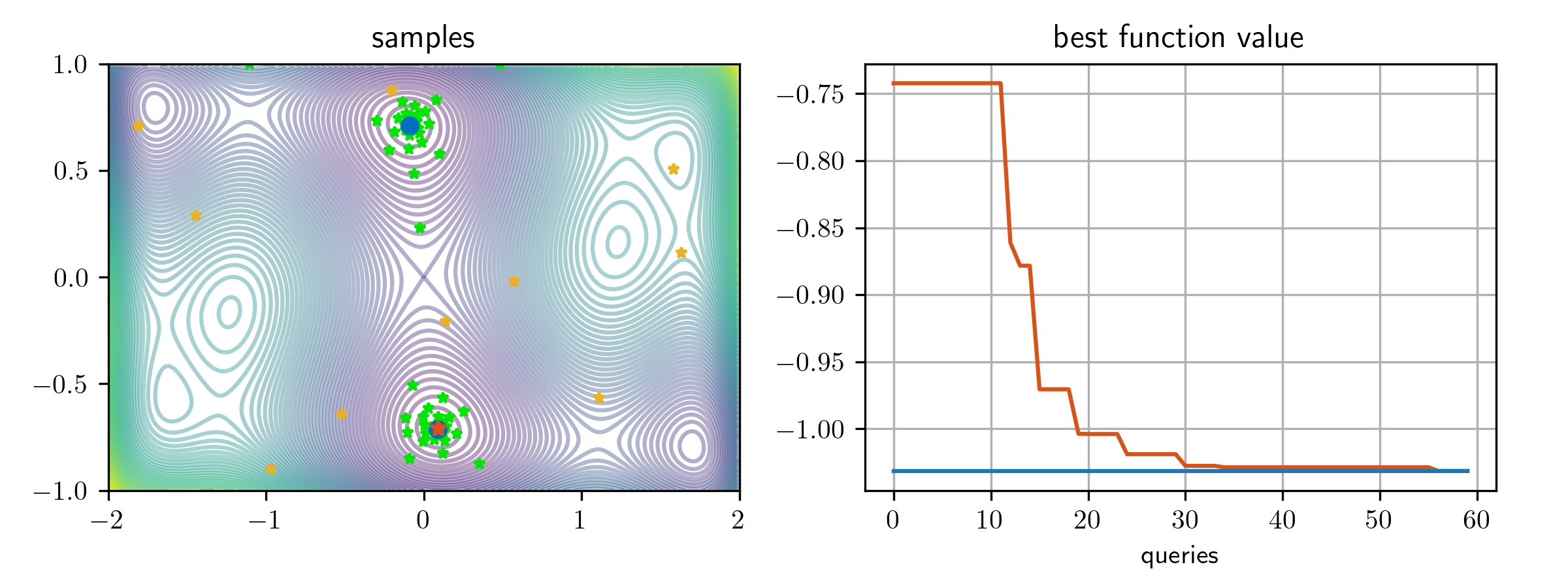
The yellow stars are the initial samples randomly generated by LHS, the green stars are the samples queried by GLIS during the active learning stage, the blue circles are the known global optimal solutions, and the red star is the optimizer identified by GLIS.
Next, we add linear constraints $Ax\leq b$ and the nonlinear constraint $g(x)=x_1^2+(x_2+0.1)^2-\frac{1}{2}\leq 0$
A = np.array([[1.6295, 1],[-1, 4.4553],[-4.3023, -1],[-5.6905, -12.1374],[17.6198, 1]])
b = np.array([3.0786, 2.7417, -1.4909, 1, 32.5198])
g = lambda x: np.array([x[0] ** 2 + (x[1] + 0.1) ** 2 - .5])
prob = GLIS(bounds=(lb, ub), A=A, b=b, g=g, n_initial_random=10)
xopt, fopt = prob.solve(fun, max_evals)
GLIS determines now a new optimizer within the given constraints:
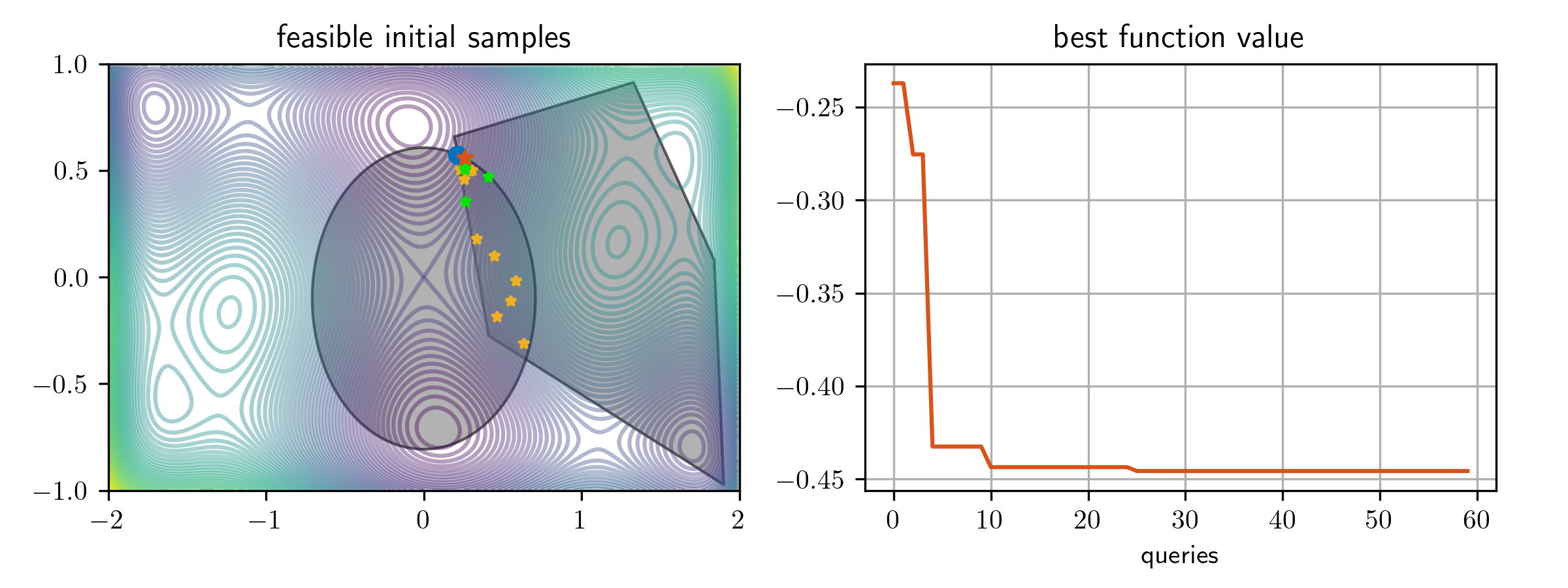
In this case, the feasible region is the intersection of an ellipsoid and a polytope. Note that there is no requirement in GLIS that the constraints define a convex set.
More examples of numerical benchmark testing using GLIS can be found in the examples folder.
Preference-based global optimization (GLISp)
To solve a preference-based optimization problem with preference function $\pi(x_1,x_2)$, $x_1,x_2\in\mathbb{R}^n$
within the finite bounds lb $\leq x\leq$ ub use the following code:
from glis.solvers import GLISp
prob = GLISp(bounds=(lb, ub), n_initial_random=10) # initialize GLISp object
xopt = prob.solve(pref_fun, max_prefs) # solve problem
where pref_fun is the Python function implementing $\pi(x_1,x_2)$, n_initial_random is the number of random samples taken at initialization, and max_prefs is the total allowed budget of preference queries collected from max_prefs+1 samples. The code returns the most preferred vector xopt found.
If additional preference queries can be done after running the optimization, the latter can be continued as follows:
xopt = prob.xbest # current best sample found
x = prob.xnext # next sample to compare to xopt
pref = pref_fun(x, xbest) # evaluate preference function
x = prob.update(pref) # update GLISp object and get next sample to possibly query
xbest = prob.xbest # updated optimizer
Alternatively, for a full step-by-step optimization without explicitly passing the function handle pref_fun to GLISp, use the following code structure to solve the problem step by step:
from glis.solvers import GLISp
prob = GLISp(bounds=(lb, ub), n_initial_random=10) # initialize GLISp object
xbest, x = prob.initialize() # get first two random samples
for k in range(max_prefs):
pref = pref_fun(x, xbest) # evaluate preference
x = prob.update(pref)
xbest = prob.xbest
xopt=xbest # final optimizer
A synthetic preference function pref_fun can be defined from a function fun as follows:
def pref_fun(x1,x2):
# Synthetic preference function mapping (x1,x2) to {-1,0,1}
tol = 1.e-3
f1 = fun(x1)
f2 = fun(x2)
if f1 <= f2 - tol:
pref = -1
elif f1 >= f2 + tol:
pref = 1
else:
pref = 0
return pref
Example (cont'd)
We apply GLISp for optimizing the camel-six-humps function $f(x)$ by acquiring the preferences
$\pi(x_1,x_2)=-1$ if $f(x_1)\leq f(x_2)-10^{-4}$,
$\pi(x_1,x_2)=1$ if $f(x_1)\geq f(x_2)+10^{-4}$,
$\pi(x_1,x_2)=0$ if $|f(x_1)-f(x_2)|<10^{-4}$,
obtaining xopt = (-0.09967807, 0.71635488) (corresponding to $f($xopt$)$ = -1.0312).
Here below is a plot of the samples queried with bounds constraints:
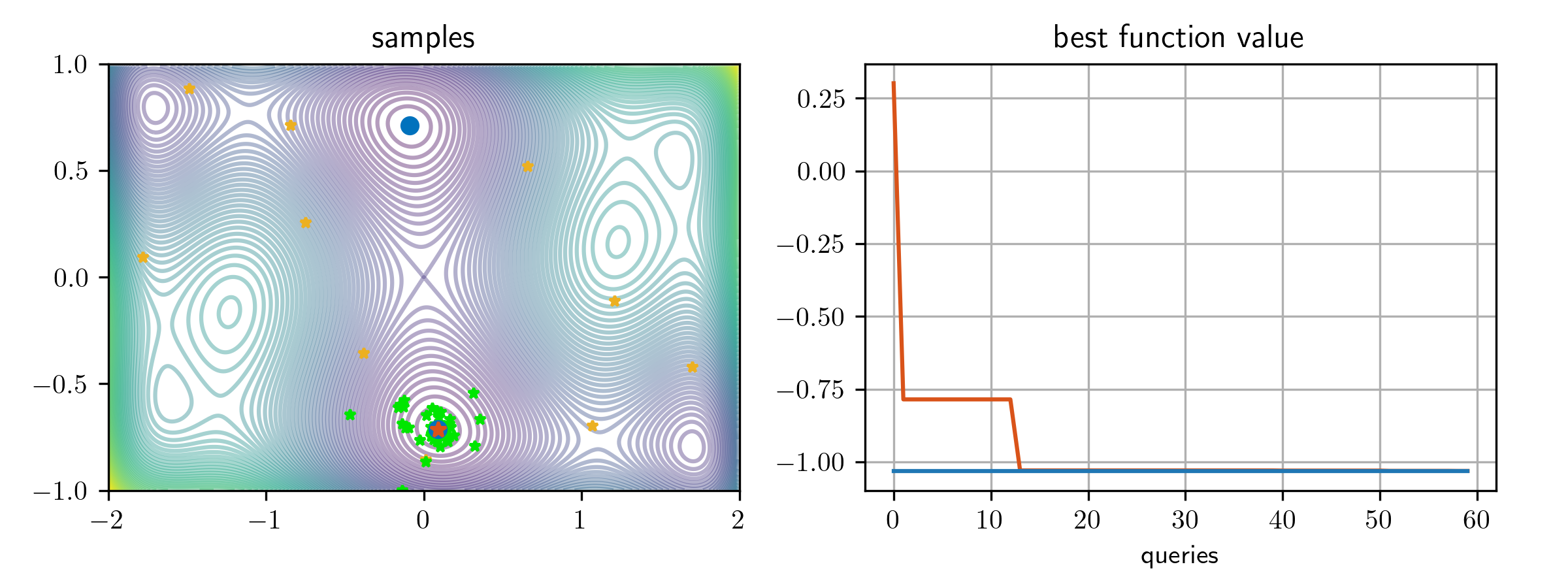
and, with additional linear and nonlinear constraints:
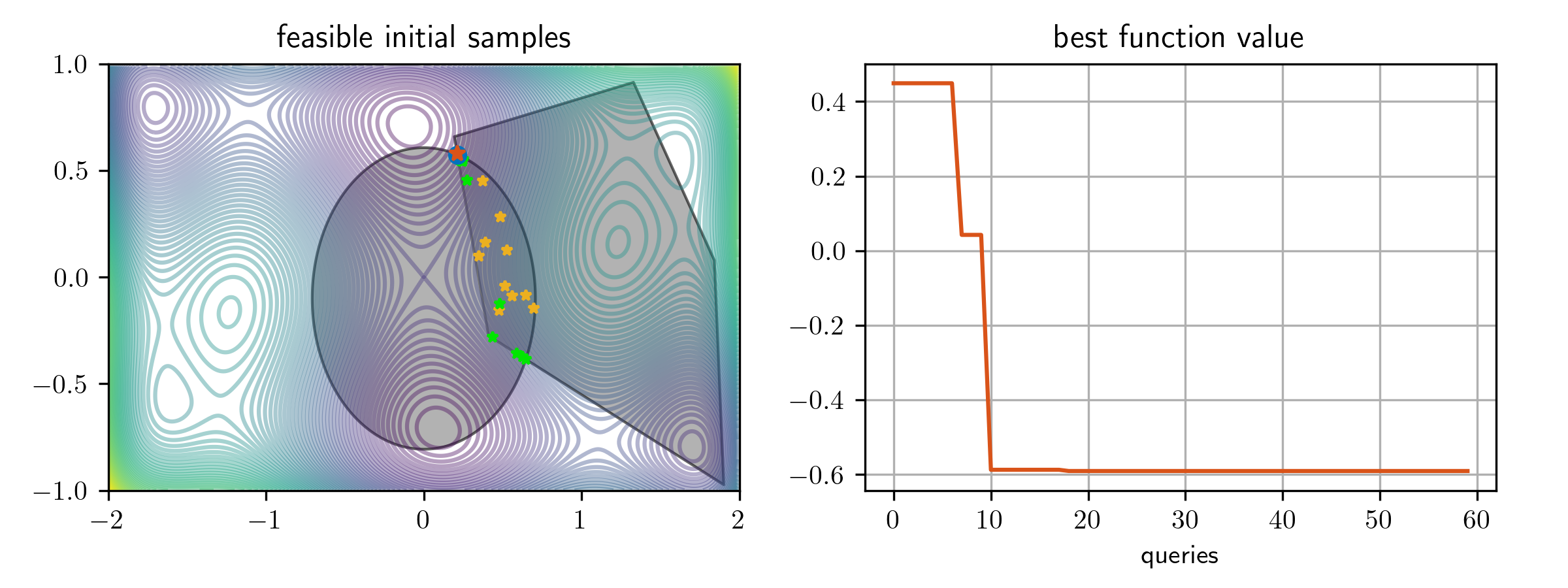
More examples of numerical benchmark testing using GLISp can be found in the examples folder.
Advanced options
Surrogate function
By default, GLIS/GLISp use the inverse quadratic RBF
$$rbf(x_1,x_2)=\frac{1}{1+(\epsilon||x_1-x_2||_2)^2}$$
with $\epsilon=1$ to construct the surrogate of the objective function. To use a different RBF, for example the Gaussian RBF
$$rbf(x_1,x_2)=e^{-(\epsilon||x_1-x_2||_2)^2}$$
use the following code:
from glis.rbf import gaussian
prob = GLIS(bounds=(lb, ub), n_initial_random=10, rbf=gaussian, rbf_epsil=3.0)
xopt, fopt = prob.solve(fun, max_evals)
The following RBFs are available in glis:
from glis.rbf import gaussian, inverse_quadratic, multiquadric, thin_plate_spline, linear, inverse_multi_quadric
In alternative to RBF functions, in GLIS we can use inverse distance weighting (IDW) surrogates:
prob = GLIS(bounds=(lb, ub), n_initial_random=10, rbf='IDW')
xopt, fopt = prob.solve(fun, max_evals)
Although IDW functions are simpler to evaluate, usually RBF surrogates perform better.
Acquisition function
GLIS acquires a new sample $x_k$ by solving the following nonlinear programming problem
$$\min_x a(x)=\hat f(x) -\alpha s^2(x) - \delta\Delta F z(x)$$
$$l \leq x\leq u$$
$$Ax \leq b,\ g(x)\leq 0$$
where $\hat f$ is the surrogate (RBF or IDW) function, $s^2(x)$ the IDW variance function, and $z(x)$ the IDW exploration function. GLIS attempts at finding a point $x_k$ where $f(x)$ is expected to have the lowest value ( $\min \hat f(x)$ ), getting $x_k$ where the surrogate is estimated to be most uncertain ( $\max s^2(x)$ ), and exploring new areas of the feasible space ( $\max z(x)$ ). The hyperparameters $\alpha$ and $\delta$ determine the tradeoff ( $\Delta F$ is the current range of values of $f(x)$ collected so far and is used as a normalization factor).
GLIS uses Particle Swarm Optimization (PSO) to determine the minimizer $x_k$ of the acquisition problem, whose objective function $a(x)$ is cheap to evaluate.
By default, GLIS takes $\alpha=1$ and $\delta=\frac{1}{2}$. Increasing these values promotes exploration of the sample space, and particular increasing $\delta$ promotes diversity of the samples, indipendently on the function values $f(x)$ acquired, while increasing $\alpha$ promotes the informativeness of the samples and heavily depends on the constructed surrogate function $\hat f$.
To change the default values of the hyper-parameters $\alpha$ and $\delta$, use the following code:
prob = GLIS(bounds=(lb, ub), alpha=0.5, delta=0.1)
GLISp performs acquisition in a similar way than GLIS. The surrogate $\hat f$ is determined by determining the combination of RBF coefficients, through linear programming, that make the resulting $\hat f$ satisfy the collected preference constraints. The parameter $\alpha$ is ignored.
GLISp also supports, in alternative, the acquisition based on the maximimization of the probability of improvement, as defined in [2]. This can be specified as follows:
prob = GLISp(bounds=(lb, ub), acquisition_method="prob_improvement")
By default, acquisition_method = "surrogate".
RBF recalibration
The performance of GLISp can be usually improved by recalibrating the RBF parameter $\epsilon$. This is achieved by performing leave-one-out cross-validation on the available samples to find the scaling $\epsilon\leftarrow\theta\epsilon$ providing the surrogate function that best satisfies the given preference constraints:
prob = GLISp(bounds=(lb, ub), RBFcalibrate=True, RBFcalibrationSteps=steps, thetas=thetas)
where steps is an array of step indices at which recalibration must be performed, and thetas is the array of values of $\theta$ tested during recalibration.
To force the recalibration of the RBF at any time, use the command prob.rbf_recalibrate(), which computes the optimal value prob.theta of the scaling factor $\theta$.
Unknown constraints and satisfactory samples
As detailed in [3], GLIS/GLISp can handle unknown constraints on $x$, where the shape of $X$ is unknown, and support labeling samples $x$ as satisfactory or not. To instruct the solver to collect such extra information during queries, use the following code:
prob = GLIS(bounds=(lb, ub), n_initial_random=13, has_unknown_constraints=True, has_satisfaction_fun=True)
xopt, fopt = prob.solve(fun, max_evals=50, unknown_constraint_fun=f1, satisfactory_fun=f2)
where f1 and f2 are the Python functions of $x$ determining, respectively, whether $x$ is feasibile with respect to unknown constraints and satisfactory. The value returned by f1 and f2 must be Boolean (True = feasible/satisfactory, False otherwise).
To solve the same problem in iterative form in GLIS, use the following example:
prob = GLIS(bounds=(lb, ub), n_initial_random=n_initial_random)
x = prob.initialize()
for k in range(max_evals):
f = fun(x)
fes = f1(x)
sat = f2(x)
x = prob.update(f, fes, sat)
xopt=prob.xopt
fopt=prob.fopt
A numerical benchmark with unknown constraints solved by GLIS can be found in file glis_unknown_constraints.py in the examples folder
while in GLISp:
prob = GLISp(bounds=(lb, ub), n_initial_random=n_initial_random, RBFcalibrate=True)
xbest, x = prob.initialize() # get first two random samples
prob.eval_feas_sat(xbest, unknown_constraint_fun=f1, satisfactory_fun=f2)
for k in range(max_prefs):
pref = pref_fun(x, xbest) # evaluate preference
prob.eval_feas_sat(x, unknown_constraint_fun=f1, satisfactory_fun=f2)
x = prob.update(pref)
xbest = prob.xbest
xopt = xbest
Numerical benchmarks with unknown constraints solved by C-GLISp (detailed in [3] ) can be found in glisp_unknown_constraints.py in the examples folder.
Objective function transformation
In GLIS, when the objective function has very large and very small values, it is possible to fit the surrogate of a nonlinear transformation of the objective rather the raw objective values. For example, in the camel-six-humps example we want to build the surrogate $\hat f(x)\approx \log(f(x+2))$ rather than $\hat f(x)\approx f(x)$. In GLIS, you can specify the transformation function as an optional argument:
prob = GLIS(bounds=(lb, ub), obj_transform=lambda f: np.log(f+2.), n_initial_random=10)
xopt, fopt = prob.solve(fun, max_evals)
Compare the best objective values found $f(x)$ of the camel-six-humps function:
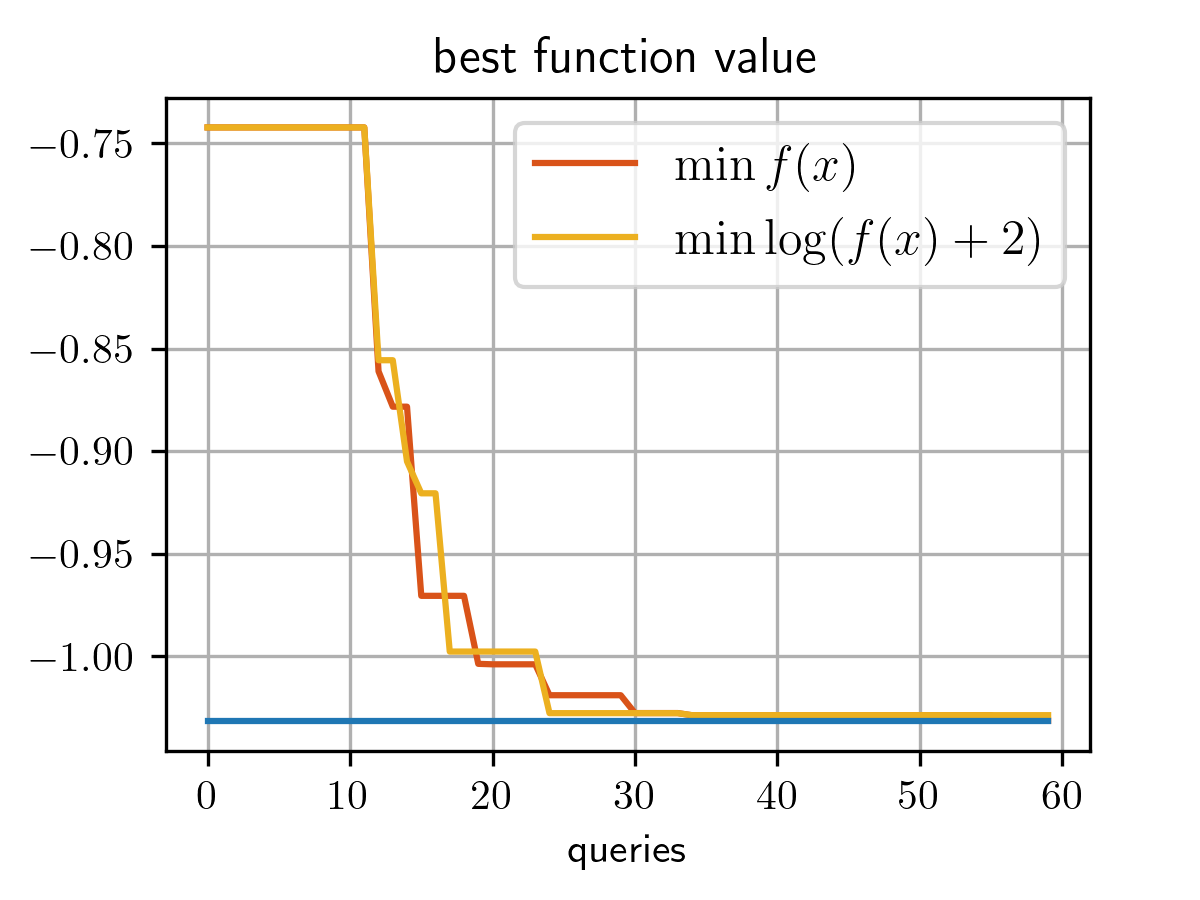
Other options
Further options in executing GLIS/GLISp are detailed below:
svdtol tolerance used in SVD decomposition when fitting the RBF function.
shrink_range flag, if True the given bounds bounds are shrunk to the bounding box of the feasible constrained set $X={x: Ax\leq b, g(x)\leq 0}$.
constraint_penalty penalty used to penalize the violation of the constraints $Ax\leq b$, $g(x)\leq 0$ during acquisition.
feasible_sampling flag, if True all the initial samples satisfy the constraints $Ax\leq b$, $g(x)\leq 0$.
scale_delta flag, scale $\delta$ during the iterations, as described in [3].
expected_max_evals expected maximum number of queries (defaulted to max_evals when using GLIS.solve().
display verbosity level: 0 = none (default).
PSOiters, PSOswarmsize, PSOminfunc: parameters used by the PSO solver from the pyswarm
package used by GLIS.
sepvalue (GLISp only): amount of separation $\hat f(x_1)-\hat f(x_2)$ imposed in the surrogate function when imposing preference constraints.
epsDeltaF (GLISp only): lower bound on the range of the surrogate function.
Contributors
This package was coded by Alberto Bemporad and Mengjia Zhu. Marco Forgione and Dario Piga also contributed to the development of the package.
This software is distributed without any warranty. Please cite the above papers if you use this software.
Citing GLIS
@article{Bem20,
author={A. Bemporad},
title={Global optimization via inverse distance weighting and radial basis functions},
journal={Computational Optimization and Applications},
volume=77,
pages={571--595},
year=2020
}
@article{BP21,
title={Active preference learning based on radial basis functions},
author={A. Bemporad and D. Piga},
journal={Machine Learning},
volume=110,
number=2,
pages={417--448},
year=2021
}
@article{ZPB22,
author={M. Zhu and D. Piga and A. Bemporad},
title={{C-GLISp}: Preference-Based Global Optimization under Unknown Constraints with Applications to Controller Calibration},
journal={IEEE Transactions on Control Systems Technology},
month=sep,
volume=30,
number=3,
pages={2176--2187},
year=2022
}
License
Apache 2.0
(C) 2019-2023 A. Bemporad, M. Zhu
Project details
Release history Release notifications | RSS feed
Download files
Download the file for your platform. If you're not sure which to choose, learn more about installing packages.











